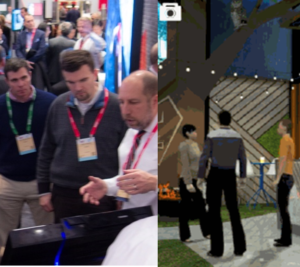By May of 2020, the world had come to understand that live trade shows would not be held for the foreseeable future which is a struggle for most trade show booth design companies. Gone was the possibility to meet large groups of customers and prospects face-to-face with solutions designed to help accomplish business objectives.
It is now the end of 2020 and the guessing game continues. When will we be able to gather in large groups safely? When will we be able to put up custom trade show exhibits? Will business travel rebound to levels enjoyed in early 2020? Now that most companies have experienced remote work and buyers have learned to evaluate products and solutions online, will the sales process be forever changed?
Despite these market uncertainties, the demand for commerce has not gone away. Once over the initial shock, companies began looking for alternative paths to engage potential buyers. Associations, the typical organizer for large trade shows, also began seeking a “stop-gap” in the form of a virtual offering.
Turning to virtual events, associations, vendors and exhibitors have all been on a steep learning curve around the digital technology required. In addition, each of these stakeholders have struggled to understand the value of the investment created by their participation. This is especially true for exhibitors who typically dedicate a large portion of their marketing budget to meet customers face-to-face and have learned how to measure the value of show participation in light of established objectives.
Exhibiting on a virtual platform has rarely been tested until now. This new approach requires a re-evaluation of objectives and a new definition of success. At Exhibitus, as we have helped guide our clients into the virtual world, it has become evident that although the live and virtual worlds are different, the planning for participation has its similarities.
The discussion below points to familiar aspects of face-to-face marketing to consider in the virtual world:
Set goals and objectives to determine what metrics will be used to measure success
No matter the format or approach, being able to prove the value of participation is a corporate requirement. The results of initial events can provide a baseline for measuring success in the future. As with live events, studying the results for each virtual event can identify ways to continually improve performance and gain confidence that the platform will meet desired goals.
Define the target audience
As in live events, meeting marketing and sales objectives can only happen if you are talking to the right people, those who need your product or solution, and have a role in making a purchase decision. Determining the audience for an event and then defining your specific target audience should be similar to the qualification methodology your company uses for live events.
Develop a branded environment
It will not be a physical structure, but a virtual environment must strongly support your brand with the same attributes you would use on a trade show floor. Many virtual exhibitors mimic their current exhibit because it is familiar to their target audience, with messaging that has proven successful in the past. Others choose the opportunity to showcase their brand with different digital presence before they commit budget dollars to a new build of an exhibit. Whatever the approach, brand and messaging are still important drivers in creating an engaging environment.
Prepare your staff
In a live world, it is said that an exhibit staff accounts for roughly 80 percent of an event’s success. The figure most likely is the same or higher in the virtual world. A visitor looking for a live product demonstration will expect an expert “manning the booth.” Training your staff to effectively use the technology and to understand the visitor’s side of the experience is critical to successful interactions. Also, given the limited amount of time a visitor may spend in your virtual exhibit, the staff must ask the right questions to qualify that visitor as a prospect, same as on a trade show floor.
Follow-up after the show
For live events, sales and marketing teams are expected to follow up with visitors according to a company-approved cadence of interaction. Post-show follow up should be no different. Quickly reach out to virtual visitors and let them know there are people behind the digital screens. Start developing relationships in the virtual world and look forward to the day you can meet face-to-face.
In future editions of the Exhibitus blog, we will discuss ways that virtual events differ from live events and how you can address those changes.
Whether planning a live or virtual event, contact us. We are ready to help you meet all face-to-face objectives whether on a trade show floor or through a digital experience on a virtual platform.

